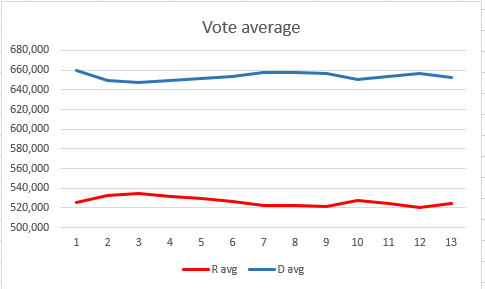This one is short and sweet, and really could have been the entry level way of looking at the question “who is more likely to lose voters down the ballot when straight ticket voting is gone, Dems or Republicans?” We agree that there are a ton of judicial elections on the Harris County ballot. It’s more in the off years than the Presidential years, and this year there were 67 such races, including the 1st and 14th Courts of Appeals, but not including the statewide positions and the JP races. These are the races where we’d expect those fabled “fatigued” voters to give up and skip to the “cast ballot” button, thus leaving some candidates out in the cold. What actually happened this year, with this ridiculously long ballot?
Well, the way I look at it here is to look at the vote totals for each party’s candidates as we get further and further down the ballot. To smooth out the variances a bit, I grouped the judicial races into fives, and averaged the vote totals for each party. Here’s how that looked for 2018:
R avg D avg
===============
525,105 659,269
532,722 649,946
534,714 647,210
531,416 649,545
529,551 651,147
526,579 653,219
522,370 657,782
522,130 657,317
521,753 656,926
527,228 650,895
524,574 653,409
520,817 656,424
The last group has seven races in it, as there were 67 in total. The first five appellate races are for whatever the reason different than everything that comes after them, but as you can see the total range of votes is fairly limited. Once again, we see that – again, with an odd blip three from the end – Dems do a better job of hanging onto their voters than the Republicans do. Here’s how this looks as a chart:
Again, I think the data is a bit mixed, and we don’t really know how the people who have been voting straight tickets will behave once that’s not an option. My point continues to be that it’s ridiculous and unsupported by the data to make assertions about what will happen once this change is implemented. Among other things, voters (and parties and candidates) have two years to absorb the idea of the change and to make adjustments for it. Here in Harris County, as in some other bigger counties, we can now take steps to ensure that the longer time it takes to complete a ballot will not lead to longer lines and voter frustration, so that may help mitigate the more unsavory parts of this change. It may well be when all is said and done and we have some more elections under our belt that Dems do see more dropoff in their races. I don’t think that will happen, or if it does that it will be a significant effect, but it could. Whatever does happen, let’s remember what was said before anyone could know for sure.


I think charles should run for city council.
All he has to do is just copy the ideas off my website just like jonita reynolds copied the ideas i googled off of my cover letter and exit interview.